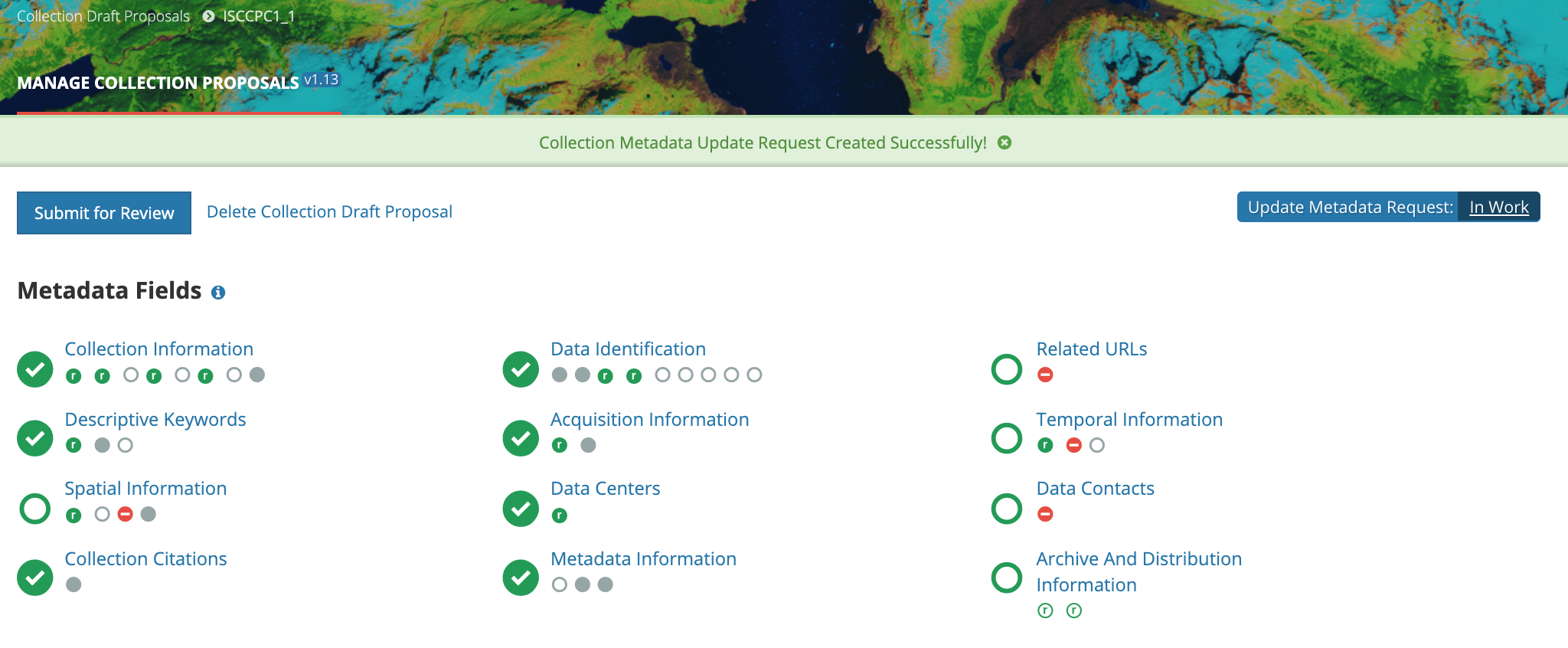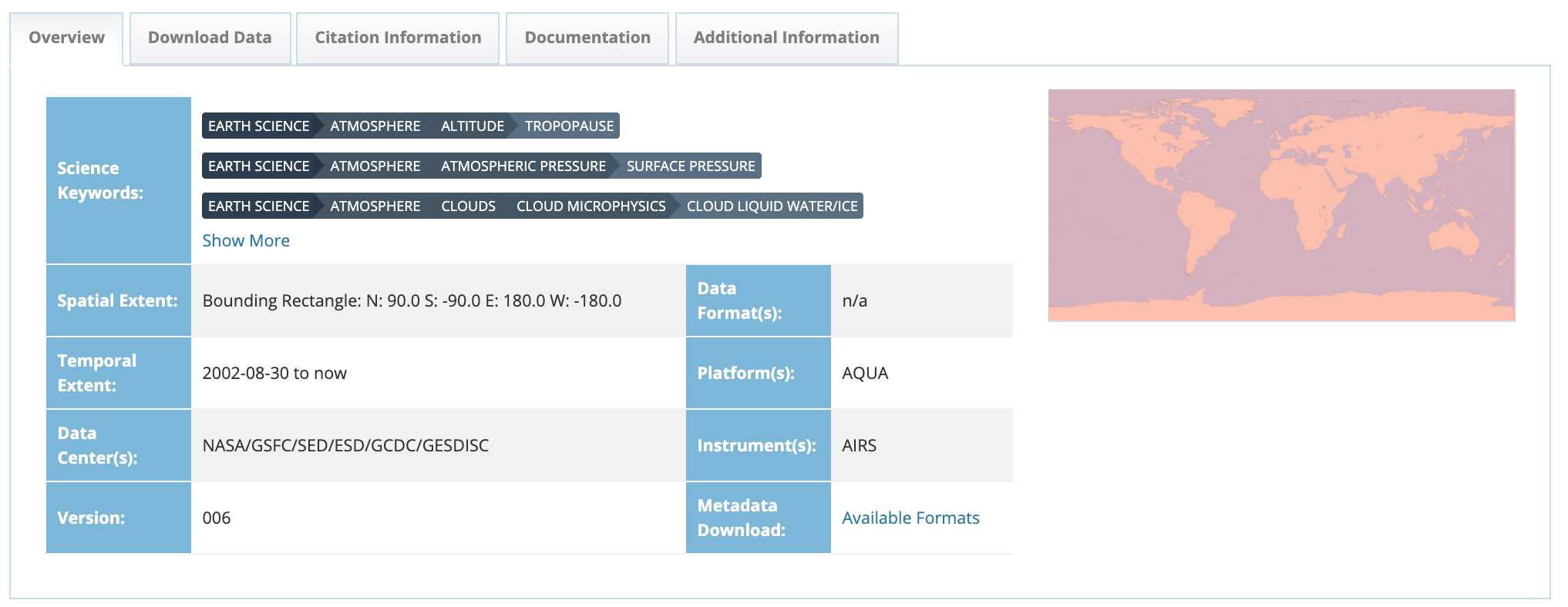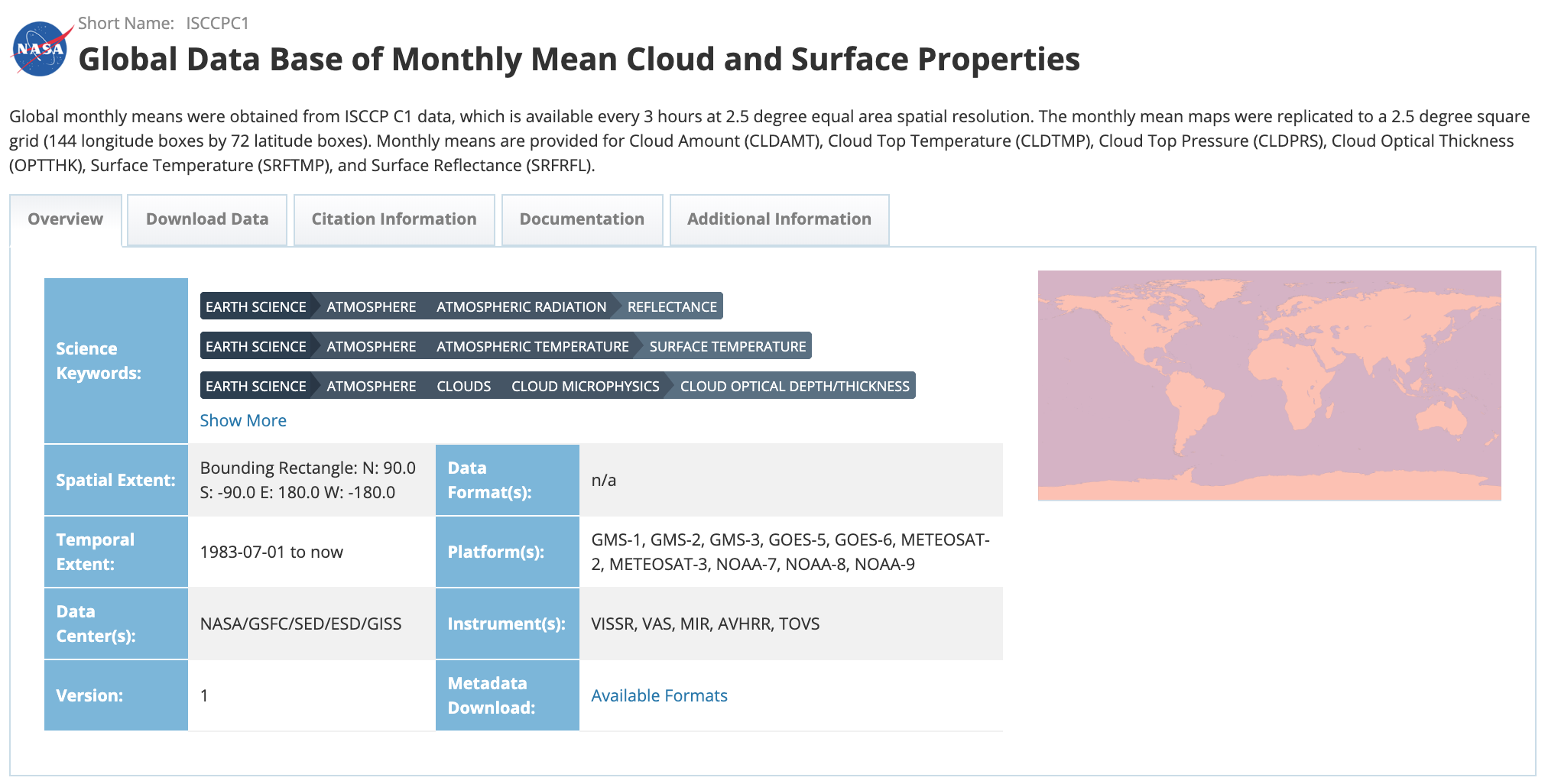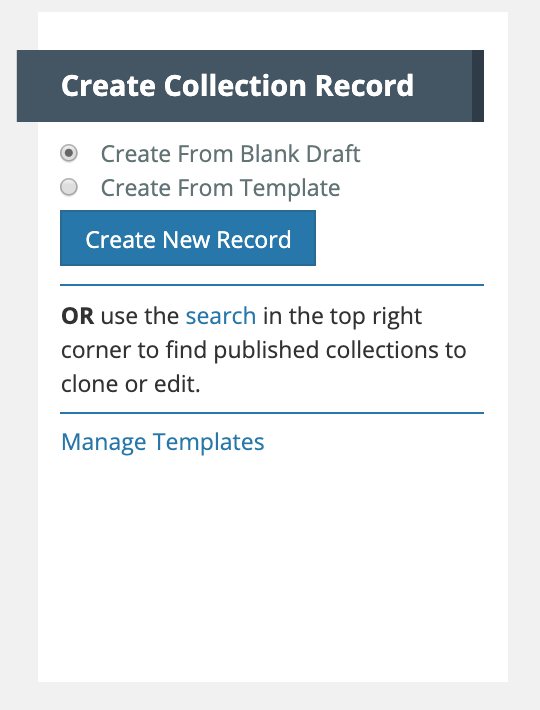Page History
...
To view an html representation of the metadata for any collection record in the search results table, click on the Short Name of the collection.
...
Submit a request to update a published collection record in the CMR using the dMMT
1. Find the collection record using the instructions above ('Find and View Published Collections in the CMR)', and click on the Short Name of the collection to view the collection information page.
...
3. A new draft of this record will be created in the MMT dMMT database. The MMT dMMT will display the progress panel (and html representation) for the draft record.
4. On the progress panel, click on any section to begin editing the draft record. Use the progress panel and navigation buttons described in in 'Create a collection record in the CMR for my provider to update and Submit a Collection Metadata Proposal' to update the metadata in the draft record.
5. When you have finished editing the draft record, publish it to the CMR submit it for review by clicking on the Publish Draft 'Submit for Review' button above the progress panel on the draft proposal record page:
. This will create a new revision of the collection record once it is approved and published in the CMR. The CMR stores up to 10 revisions of each collection record. When an 11th revision is created, the first revision is deleted, and so on. Each revision of a collection record has the same concept id as the original collection record.
Clone and edit a collection record in the CMR for my provider
1. Find the collection record using the instructions above (Find and View Collections in the CMR), and click on the Short Name of the collection to view the collection information page.
2. At the top of the collection information page, click on 'Clone Collection Record'
3. A draft of a clone of this record will be created in the MMT database. The MMT will display the progress panel (and html representation) for the draft record (the clone).
Since collection Short Names must be unique, the clone is initiated with a blank short name. The Entry Title of the clone will be initialized to '<entry title of the original record' - Cloned'. You may edit the record to change the default entry title of the clone.
NOTE: A prompt to enter a new short name for the clone appears in the blue bar, and the progress panel indicates that the Short Name has not yet been filled in.
4. On the progress panel, click on any section to begin editing the draft record (the clone). You must enter a new Short Name for the clone. Use the progress panel and navigation buttons described above (Create a collection record in the CMR for my provider) to update the metadata in the draft record. 5. When you have finished editing the draft record (the clone), publish it to the CMR by clicking on the Publish Draft button above the progress panel. The clone will be stored as a new collection record in the CMR, with a different concept id from the original record.
Download XML for a collection record in the CMR using the dMMT
1. Find the collection record using the instructions above ('Find and View Published Collections in the CMR)', and click on the Short Name of the collection to view the collection information page.
2. On the Overview tab of the collection information page, click on Metadata Download: 'Available Formats'.
3. You will see a pop-up window asking you to choose the format in which you would like to download the collection metadata.
...
4. Click on the format that you would like. Your browser and local machine will now prompt you through the download process.
...
Submit a request to delete a published collection record in the CMR
...
using the dMMT
1. Find the collection record using the instructions above ('Find and View Published Collections in the CMR)', and click on the Short Name of the collection to view the collection information page.
2. At the top of the collection information page, click on 'Submit Delete Collection RecordRequest'.
3. You will see a pop-up message asking you to confirm the record deletion request.
4. Click on Yes to submit the delete the recordrequest. The MMT dMMT will then display a 'Collection Deleted Metadata Delete Request Created Successfully!' message, as well as the revision history for the deleted record. The . After the delete request is approved and processed, the CMR will create a final revision for the deleted record, which is called a tombstone.
5. NOTE that you can immediately restore cancel the deleted record from one of the revisions on this Revision History table by clicking on 'Reinstate', but once you have moved to a new page on the MMT, you will no longer be able to find the deleted record to restore it. If you restore the record from this table, you will see a new revision history, showing the deletion as one of the revisions:
Revert to a previous revision of a collection record in the CMR for my provider
1. Find the collection record using the instructions above (Find and View Collections in the CMR), and click on the Short Name of the collection to view the collection information page.
2. At the top of the collection information page, click on 'Revisions (<number of revisions>)'
3. A table of the (up to) 10 most recent revisions of the collection record will be displayed.
4. You may View previous revisions of the record by clicking on the 'View' link next to the Revision Description. After you determine which revision you want to revert to, click on 'Revert to this Revision' in the Actions column for that revision. You will see a pop-up message asking you to confirm the action:
5. Click on Yes to revert to the selected previous revision of the record. The MMT will then display a 'Revision Created Successfully!' message, as well as the new revision history for the record. If there were n revisions before you reverted to a previous revision, there will now be n+1 revisions, and the n+1st revision will be identical to the previous revision to which you reverted.
Create and Manage Collection Record Templates
Create a collection record template for my provider
On the 'Manage Collections' dashboard, in the Create Collection Record panel, click on ‘Manage Templates’.
2. On the provider templates page, click on ‘Create a Collection Template’. A draft collection record template will be created.
3. Begin filling in metadata fields for your draft collection record. Use the information icons (blue 'i') to get information about what fields mean and how to format their values.
4. Navigate from form to form using the Previous or Next buttons, or by choosing the next form to edit from the pull-down list at 'Save & Jump To:'. You may work on forms in any order. When you move from one form to another, your input from the previous form will be saved in your draft record template. Explicitly Save form input (within a session or at the end of a session) with the 'Save' button. To save your draft record template, select the 'Done' button.
You will see a green banner indicating that your collection record template has been successfully created. NOTE: When you are working with a draft collection record template, all 'Save' and 'Done' operations update the draft record template in the MMT database, not in the CMR. Draft collection record templates can be used to create draft collection records that can then be ingested into the CMR.
5. Follow progress of your draft record template on the progress panel:
The icons on the progress panel have the following meanings:
6. View an HTML rendering of your collection record template on the 'preview panel':
7. Special NOTES when creating or editing a collection level record template:
a. To have the NRT (Near Real Time) badge appear for the collection on the Earthdata Search Client, set Collection Type to 'Near Real Time' on the 'Data Information' form.
b. On the 'Temporal Extent' form, Ends at Present should be set to False if there is an end date for the collection.
...
delete record request by clicking on 'Cancel Delete Request'.
Report problems or get help with dMMT
...

























